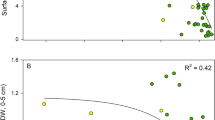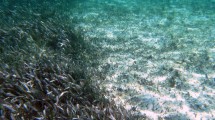Abstract
Species of the macroalgae Caulerpa sp. are increasingly being observed in meadows of the endemic Mediterranean seagrass Posidonia oceanica, and in particular Caulerpa taxifolia, has been considered as an invasive species leading to seagrass decline. Studies have so far failed to reveal the underlying mechanisms of the success of the macroalgae, and here, we examine how biogeochemical changes of the environment associated to indigenous (Caulerpa prolifera) and non-indigenous (Caulerpa racemosa and C. taxifolia) species affect the habitat of P. oceanica. Two of the species (C. prolifera and C. racemosa) affect the sediment biogeochemical conditions by increasing organic matter pools, microbial activity, and sulfide pools of the sediments, and limited effects were found for C. taxifolia. Biomass of the macroalgae contributed to the extent of impacts, and high sulfide invasion into the seagrasses and regression of the meadow were pronounced at the location with the highest Caulerpa biomass. This suggests that Caulerpa invasion contributes to seagrass decline probably because Caulerpa thrives better than the seagrasses in the modified environment.





Similar content being viewed by others
References
Blomqvist, S., and L. Håkanson. 1981. A review on sediment traps in aquatic environments. Archieves of Hydrobiologia 91: 101–132.
Calleja, M.L.l., N. Marbà, and C.M. Duarte. 2007. The relationship between seagrass (Posidonia oceanica) decline and sulfide porewater concentration in carbonate sediments. Estuarine, Coastal and Shelf Science 73: 583–588. doi:10.1016/j.ecss.2007.02.016.
Ceccherelli, G., and D. Campo. 2002. Different effects of Caulerpa racemosa on two co-occurring seagrasses in the Mediterranean. Botanica Marina 45: 71–76. doi:10.1515/BOT.2002.009.
Ceccherelli, G., and N. Secchi. 2002. Nutrient availability in the sediment and the reciprocal effects between the native seagrass Cymodocea nodosa and the introduced rhizophytic alga Caulerpa taxifolia. Hydrobiologia 474: 57–66. doi:10.1023/A:1016514621586.
Ceccherelli, G., L. Piazzi, and F. Cinelli. 2000. Response of the non-indigenous Caulerpa racemosa (Forsskål) J. Agardh to the native seagrass Posidonia oceanica (L.) Delile: Effect of density of shoots and orientation of edges of meadows. Journal of Experimental Marine Biology and Ecology 243: 227–240. doi:10.1016/S0022-0981(99)00122-7.
Chisholm, J.R.M., and P. Moulin. 2003. Stimulation of nitrogen fixation in refractory organic sediments by Caulerpa taxifolia (Chlorophyta). Limnology and Oceanography 48: 787–794.
Chisholm, J.R.M., F.E. Fernex, D. Mathieu, and J.M. Jaubert. 1997. Wastewater discharge, seagrass decline and algal proliferation on the Côte d’Azur. Marine Pollution Bulletin 34: 78–84. doi:10.1016/S0025-326X(96)00072-0.
Cline, J.D. 1969. Spectrophotometric determination of hydrogen sulphide in natural waters. Limnology and Oceanography 14: 454–458.
Diaz-Almela, E., E. Alvarez, R. Santiago, N. Marbà, M. Holmer, T. Grau, R. Danovaro, M. Argyrou, Y. Karakassis, and C.M. Duarte. 2008. Benthic inputs as predictors of seagrass (Posidonia oceanica) fish farm-induced decline. Marine Pollution Bulletin 56:1332–1342.
Didham, R.K., J.M. Tylianakis, M.A. Hutchinson, R.M. Ewers, and N.J. Gemmell. 2005. Are invasive species the drivers of ecological change? Trends in Ecology and Evolution 20: 470–474. doi:10.1016/j.tree.2005.07.006.
Fossing, H., and B.B. Jørgensen. 1989. Measurement of bacterial sulphate reduction in sediments: Evaluation of a single-step chromium reduction method. Biogeochemistry 8: 205–222. doi:10.1007/BF00002889.
Frederiksen, M.S., M. Holmer, J. Borum, and H. Kennedy. 2006. Temporal and spatial variation of sulfide invasion in eelgrass (Zostera marina) as reflected by its sulfur isotopic composition. Limnology and Oceanography 51: 2308–2318.
Frederiksen, M.S., M. Holmer, E. Diaz-Almela, N. Marbà, and C.M. Duarte. 2007. Sulfide invasion in the seagrass Posidonia oceanica along gradients of organic loading at Mediterranean fish farms: Assessment by stable sulfur isotopes. Marine Ecology Progress Series 345: 93–104. doi:10.3354/meps06990.
Gacia, E., C.M. Duarte, and T. Granata. 1999. An approach to the measurement of particle flux and sediment retention within seagrass (Posidonia oceanica) meadows. Aquatic Botany 65: 255–268. doi:10.1016/S0304-3770(99)00044-3.
Garcias-Bonet, N., N. Marbà, M. Holmer, and C.M. Duarte. 2008. Effects of sediment sulfides on seagrass (Posidonia oceanica) meristematic activity. Marine Ecology Progress Series 372:1–6.
Goodman, J.L., K.A. Moore, and W.C. Dennison. 1995. Photosynthetic responses of eelgrass (Zostera marina) to light and sediment sulfide in a shallow barrier island lagoon. Aquatic Botany 50: 37–47. doi:10.1016/0304-3770(94)00444-Q.
Hargrave, B.T., and N.M. Burns. 1979. Assessment of sediment trap collection efficiency. Limnology and Oceanography 24: 1124–1136.
Holmer, M., and E.J. Bondgaard. 2001. Photosynthetic and growth response of eelgrass to low oxygen and high sulfide concentrations during hypoxic events. Aquatic Botany 70: 29–38. doi:10.1016/S0304-3770(00)00142-X.
Holmer, M., and M.S. Frederiksen. 2007. Stimulation of sulfate reduction rates in Mediterranean fish farm sediments. Biogeochemistry 85: 169–185. doi:10.1007/s10533-007-9127-x.
Holmer, M., C.M. Duarte, H.T.S. Boschker, and C. Barrón. 2004. Carbon cycling and bacterial carbon sources in pristine and impacted Mediterranean seagrass sediments. Aquatic Microbial Ecology 36: 227–237. doi:10.3354/ame036227.
Jørgensen, B.B. 1978. Comparison of methods for the quantification of bacterial sulfate reduction in coastal marine sediments 2. Calculation from mathematical-models. Geomicrobiology Journal 1: 29–47.
Jousson, O., J. Pawlowski, L. Zaninetti, F.W. Zechman, F. Dini, G. Di Guiseppe, R. Woodfield, A. Millar, and A. Meinesz. 2000. Invasive alga reaches California—The alga has been identified that threatens to smother Californian coastal ecosystems. Nature 408: 157–158. doi:10.1038/35041623.
Kaplan, I.R., K.O. Emery, and S.C. Rittenberg. 1963. The distribution and isotopic abundance of sulphur in recent marine sediments off Southern California. Geochimica et Cosmochimica Acta 27: 297–331. doi:10.1016/0016-7037(63)90074-7.
Kilminster, K.L., D.I. Walker, P.A. Thompson, and J.A. Raven. 2008. Changes in growth, internode distance and nutrient concentrations of the seagrass Halophila ovalis with exposure to sediment sulphide. Marine Ecology Progress Series 361: 83–91. doi:10.3354/meps07479.
Koch, M.S., S. Schopmeyer, C. Kyhn-Hansen, and C.J. Madden. 2007. Synergistic effects of high temperature and sulfide on tropical seagrass. Journal of Experimental Marine Biology and Ecology 341: 91–101. doi:10.1016/j.jembe.2006.10.004.
Kristensen, E., and F.Ø. Andersen. 1987. Determination of organic carbon in marine sediments: a comparison of two CHN-analyzer methods. Journal of Experimental Marine Biology and Ecology 109: 15–23. doi:10.1016/0022-0981(87)90182-1.
Marbà, N., M.A. Hemminga, M.A. Mateo, C.M. Duarte, Y.E.M. Mass, J. Terrados, and E. Gacia. 2002. Carbon and nitrogen translocation between seagrass ramets. Marine Ecology Progress Series 226: 287–300. doi:10.3354/meps226287.
Marbà, N., C.M. Duarte, E. Díaz-Almela, J. Terrados, E. Álvarez, R. Martinez, R. Santiago, E. Gacia, and A.M. Grau. 2005. Direct evidence of imbalanced seagrass (Posidonia oceanica) shoot population dynamics in the Spanish Mediterranean. Estuaries 28: 53–62. doi:10.1007/BF02732753.
Marbà, N., M. Calleja, C.M. Duarte, E. Álvarez, E. Díaz-Almela, and Holmer. 2007. Iron additions reduce sulfide intrusion and reverse seagrass (Posidonia oceanica) decline in carbonate sediments. Ecosystems 10: 745–756. doi:10.1007/s10021-007-9053-8.
Pedersen, M.F., P.A. Staehr, T. Wernberg, and M.S. Thomsen. 2005. Biomass dynamics of exotic Sargassum muticum and native halidrys siliquosa in Limfjorden, Denmark—Implications of species replacements on turnover rates. Aquatic Botany 83: 31–47. doi:10.1016/j.aquabot.2005.05.004.
Pérez, M., O. Invers, J.M. Ruiz, M.S. Frederiksen, and M. Holmer. 2007. Physiological responses of the seagrass Posidonia oceanica to elevated organic matter content in sediments: an experimental assessment. Journal of Experimental Marine Biology and Ecology 344:149–160.
Piazzi, L., and G. Ceccherelli. 2006. Persistence of biological invasion effects: Recovery of macroalgal assemblages after removal of Caulerpa racemosa var. cylindracea. Estuarine, Coastal and Shelf Science 68: 455–461. doi:10.1016/j.ecss.2006.02.011.
Piazzi, L., D. Balata, G. Ceccherelli, and F. Cinelli. 2005. Interactive effect of sedimentation and Caulerpa racemosa var. cylindracea invasion on macroalgal assemblages in the Mediterranean Sea. Estuarine, Coastal and Shelf Science 64: 467–474. doi:10.1016/j.ecss.2005.03.010.
Piazzi, L., D. Balata, L. Foresi, C. Cristaudo, and F. Cinelli. 2007. Sediment as a constituent of Mediterranean benthic communities dominated by Caulerpa racemosa var. cylindracea. Scientia marina 71: 129–135. doi:10.3989/scimar.2007.71n1129.
Rennenberg, H. 1984. The fate of excess sulfur in higher-plants. Annual Reviews in Plant Physiology and Plant Molecular Biology 35: 121–153. doi:10.1146/annurev.arplant.35.1.121.
Terrados, J., N. Marbà, S. Deudero, and A. Box. 2009. Biomass development of Caulerpa prolifera, Caulerpa taxifolia and Caulerpa racemosa var. cylindracea (Chlorophyta) under a common seasonal forcing. Journal of Phycology (in press).
Tyler, A.C., and K.J. McGlathery. 2006. Uptake and release of nitrogen by the macroalgae Gracilaria vermiculophylla (Rhodophyta). Journal of Phycology 42: 515–525. doi:10.1111/j.1529-8817.2006.00224.x.
Valiela, I., J. McClelland, J. Hauxwell, P.J. Behr, D. Hersh, and K. Foreman. 1997. Macroalgal blooms in shallow estuaries: Controls and ecophysiological and ecosystem consequences. Limnology and Oceanography 42: 1105–1118.
Verlaque, M., C.F. Boudouresque, A. Meinesz, and V. Gravez. 2000. The Caulerpa racemosa complex (Caulerpales, Ulvophyceae) in the Mediterranean Sea. Botanica Marina 43: 49–68. doi:10.1515/BOT.2000.005.
Verlaque, M., J. Afonso-Carrillo, M.C. Gil-Rodriguez, C. Durand, C.F. Boudouresque, and Y. Le Parco. 2004. Blitzkrieg in a marine invasion: Caulerpa racemosa var. cylindracea (Bryopsidales, Chlorophyta) reaches the Canary Islands (north-east Atlantic). Biological Invasions 6: 269–281. doi:10.1023/B:BINV.0000034589.18347.d3.
Acknowledgment
This research is a contribution to the MarBEF Network of Excellence, the project “Invasoras” funded by the Spanish Ministry of Education, and the project “Praderas” funded by the BBVA Foundation. MH was supported by Danish Research Council (grant no. 212-05-0408) and Thresholds (EU contract no. 003933).
Author information
Authors and Affiliations
Corresponding author
Rights and permissions
About this article
Cite this article
Holmer, M., Marbà, N., Lamote, M. et al. Deterioration of Sediment Quality in Seagrass Meadows (Posidonia oceanica) Invaded by Macroalgae (Caulerpa sp.). Estuaries and Coasts 32, 456–466 (2009). https://doi.org/10.1007/s12237-009-9133-4
Received:
Revised:
Accepted:
Published:
Issue Date:
DOI: https://doi.org/10.1007/s12237-009-9133-4




